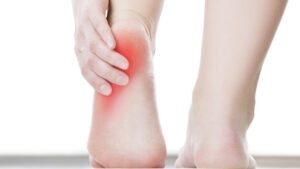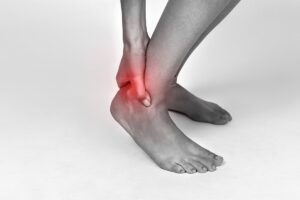PAIN IN YOUR HEEL?
Heel pain is a common foot issue. The two most common causes of pain in the heel are Plantar Fasciitis (bottom of heel) and Achilles Tendinopathy (back of heel). However, other causes of heel pain may include:
- Bursitis
- Haglund’s Deformity
- Heel Spur
- Retrocalcaneal Bursitis
- Stress Fracture
- Tarsal Tunnel Syndrome
This blog will focus on the two main causes of heel pain – Plantar Fasciitis and Achilles Tendinopathy.

Plantar Fasciitis
Plantar fasciitis is a condition that involves inflammation of the plantar fascia on the bottom of the foot. It is a tough, fibrous band of tissue that attaches to the heel bone (calcaneus) and to the base of the toes. It helps support the arch of the foot and also has an important role in normal foot mechanics during walking.
Causes
Inflammation and pain of the plantar fascia can be caused by:
- An increase in activity level (often sudden increase)
- The structure/shape of your foot
- The surface on which you walk/run
- The type of shoes you wear
- Body weight (more common in overweight individuals)
Symptoms
Plantar fasciitis usually increases gradually and is typically felt on the bottom of the heel. The pain tends to be at its most first thing in the morning, or after a period of inactivity. The degree of discomfort can sometimes lessen with activity or after warming up, but equally a bout of heavy or intense activity may worsen symptoms.
Treatment
Usually Plantar fasciitis can be treated conservatively, but can take a long time. The longer the symptoms have been present, and the more severe the pain, the longer the treatment will usually take.
Stretching is one of the most effective treatments for plantar fasciitis. Stretching exercises should be focused on the plantar fascia itself as well as the soleus and gastrocnemius muscles of the calf.
Activity modification, that helps to keep weight and stress off the foot can also help. The following methods may help:
- Switching to shoes with arch support or trying heel cups
- Applying athletic tape to the foot to support the muscles, tendons and ligaments
- Changing to more shock-absorbing exercise surfaces
- Wearing a night splint

Achilles Tendinopathy
Achilles tendinopathy is a condition that causes pain, swelling and stiffness of the Achilles tendon that joins the heel bone to the calf muscle. The function of this tendon is to help in bending your foot down at the ankle (plantarflexion).
Causes
Achilles tendinopathy is caused by repeated microtrauma to the Achilles tendon. After each injury the tendon does not heal completely, meaning that over time this damage builds up and causes the tendinopathy. There are a few things that may lead to these repeated tears, including:
- Overuse of the Achilles tendon (common in regular runners)
- Inappropriate footwear
- Poor training or exercise technique
- Making a change to your training program
- Training or exercising on hard or sloped surfaces
Symptoms
The main symptoms of Achilles tendinopathy are pain and stiffness around the affected Achilles tendon. Pain and stiffness tend to gradually develop over time and are usually worse first thing in the morning.
Some people may have pain during exercise, but in general it is worse afterwards. You may also notice that the tendon is swollen and can be warm to touch.
Treatment
There are a number of treatments that may help, often conservative:
- Relative rest – rest from aggravating exercises but still try to keep the surrounding structures moving and mobile
- Exercises – calf stretches and calf raises
- Heel cups or custom made orthotics
